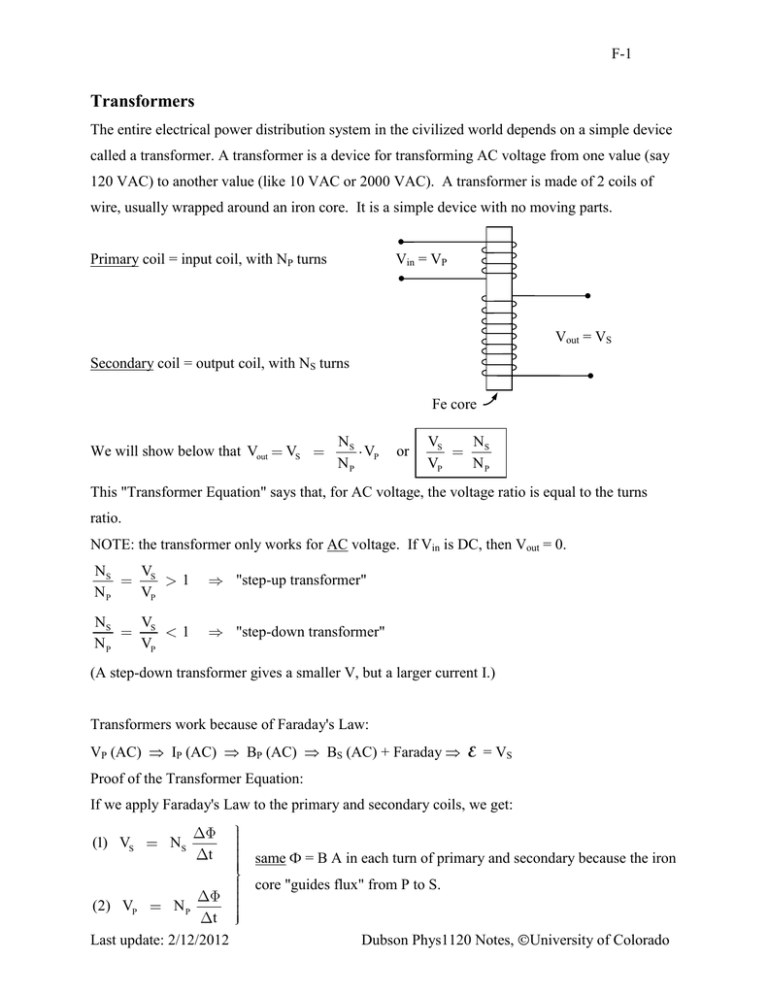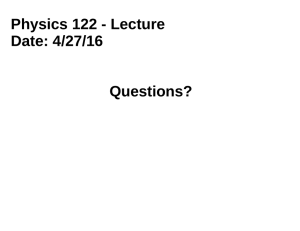Transformers - University of Colorado Boulder
advertisement

F-1 Transformers The entire electrical power distribution system in the civilized world depends on a simple device called a transformer. A transformer is a device for transforming AC voltage from one value (say 120 VAC) to another value (like 10 VAC or 2000 VAC). A transformer is made of 2 coils of wire, usually wrapped around an iron core. It is a simple device with no moving parts. Vin = VP Primary coil = input coil, with NP turns Vout = VS Secondary coil = output coil, with NS turns Fe core We will show below that Vout VS NS VP NP or VS VP NS NP This "Transformer Equation" says that, for AC voltage, the voltage ratio is equal to the turns ratio. NOTE: the transformer only works for AC voltage. If Vin is DC, then Vout = 0. NS NP VS VP 1 "step-up transformer" NS NP VS VP 1 "step-down transformer" (A step-down transformer gives a smaller V, but a larger current I.) Transformers work because of Faraday's Law: VP (AC) IP (AC) BP (AC) BS (AC) + Faraday E = VS Proof of the Transformer Equation: If we apply Faraday's Law to the primary and secondary coils, we get: (1) VS NS t same = B A in each turn of primary and secondary because the iron core "guides flux" from P to S. (2) VP NP t Last update: 2/12/2012 Dubson Phys1120 Notes, University of Colorado F-2 (1) (2) VS VP NS NP (End of proof.) If a transformer is well-designed, only 1 to 5% power in is lost to heating of coils and eddy currents in the iron core. Pout Pin IS VS = IP VP IS IP VP VS NP NS A step-down transformer produces a smaller voltage, but a bigger current (same P = I V). Light bulbs and appliances with motors (vacuum cleaners, blenders) use AC voltage to operate. But devices with electronic circuits (TV's, computers, phones, etc) need DC voltage to function. The "power supply" in computers and TV's converts the AC voltage from the wall socket into DC voltage (usually 10-15 V) that the electronic circuitry needs. Example of use of transformers: Suppose you want to melt a nail by putting a big current through it. What happens if you try to melt the nail by putting 120 VAC (from your wall socket) across the nail? Answer: you will blow a fuse or trip a breaker. The resistance of a nail is quite small: Rnail huge: Inail 10–3 . The current produced by a 120 V voltage difference across the nail is V R nail 120 V 10 3 120000 A . This will never happen since your breaker will trip when the current exceeds 15 A. (Here's an experiment you should never try at home: Bend a nail into a U shape and plug it into your wall socket. Watch the lights go out.) So how do we melt that nail? Solution: Use a 100-to-1 step-down transformer. NS NP 1 100 VS Vout IS Iout VS , VP NS VP NP VS R nail Last update: 2/12/2012 VP = Vin = 120 VAC 1 120 V 100 1.2 V 10 3 1.2 VAC 1200 A (enough to melt the nail) Dubson Phys1120 Notes, University of Colorado F-3 How much current will this draw from the wall socket? Recall that Pin = Pout or IS VS = IP VP . IP Iin IS VS VP IS NS NP (1200 A) 1 100 12 A (Not enough to blow the fuse.) Circuit diagram: VP = 120 V Rnail IP = 12 A 0.001 IS = 1200 A 100:1 symbol for transformer Power dissipated in nail = IS2 R = (1200)2 (10–3) = 1440 W will melt nail. Transformers and Power Distribution Economical power distribution is only possible because of transformers. Electrical power is transmitted from the power plant to the city by big aluminum cables (power lines). Some energy is inevitably wasted because the power lines have a resistance, and so they get hot: Plost = I2 Rcable. In order to minimize this waste, the power must be transmitted from the plant to the city at very high voltage (typically 300 kV). A high voltage allows a small current, at a given power (since P = IV). And a small current means small I2R losses in the cable. When the high-voltage power is delivered to the city, step-down transformers are used to transform the very dangerous high voltage down to the not-so-dangerous 120 V before it enters your home. The voltage is stepped down in stages as it is distributed throughout the city. Last update: 2/12/2012 Dubson Phys1120 Notes, University of Colorado F-4 step-down step-up step-down 8 kV 120 V 300 kV 20 kV Home transmission line power plant substation neighborhood A very simplified model of power distribution (transformers not shown): Rcable ( made as small as possible) I Power plant (It's really AC) Rcity (adjusted to keep total power fixed) V Some typical numbers: Power output of plant = Pout = 100 MW to 1 GW = 107 to 108 W (fixed by demands of the city) 2 Pout = I V , Plost = I Rcable Using I = Pout / V , we get Plost Fraction of power wasted = If Rcable 10 Plost Pout Pout 2 R cable V2 Pout R cable V2 and Pout = 108 W, then If V = 50,000 V : Plost Pout If V = 200,000 V : Plost Pout 108 5 104 2 10 0.4 2 10 0.025 108 2 105 (40% lost!) (2.5% lost) Boosting the voltage at which the power is transmitted makes the losses acceptably small. Last update: 2/12/2012 Dubson Phys1120 Notes, University of Colorado




